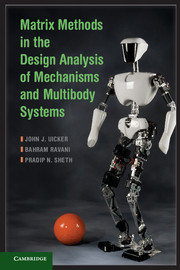Book contents
- Frontmatter
- Contents
- Preface
- About the Authors
- 1 Concepts and Definitions
- 2 Topology and Kinematic Architecture
- 3 Transformation Matrices in Kinematics
- 4 Modeling Mechanisms and Multibody Systems with Transformation Matrices
- 5 Posture Analysis by Kinematic Equations
- 6 Differential Kinematics and Numeric Solution of Posture Equations
- 7 Velocity Analysis
- 8 Acceleration Analysis
- 9 Modeling Dynamic Aspects of Mechanisms and Multibody Systems
- 10 Dynamic Equations of Motion
- 11 Linearized Equations of Motion
- 12 Equilibrium Posture Analysis
- 13 Frequency Response of Mechanisms and Multibody Systems
- 14 Time Response of Mechanisms and Multibody Systems
- 15 Collision Detection
- 16 Impact Analysis
- 17 Constraint Force Analysis
- Index
11 - Linearized Equations of Motion
Published online by Cambridge University Press: 05 April 2013
- Frontmatter
- Contents
- Preface
- About the Authors
- 1 Concepts and Definitions
- 2 Topology and Kinematic Architecture
- 3 Transformation Matrices in Kinematics
- 4 Modeling Mechanisms and Multibody Systems with Transformation Matrices
- 5 Posture Analysis by Kinematic Equations
- 6 Differential Kinematics and Numeric Solution of Posture Equations
- 7 Velocity Analysis
- 8 Acceleration Analysis
- 9 Modeling Dynamic Aspects of Mechanisms and Multibody Systems
- 10 Dynamic Equations of Motion
- 11 Linearized Equations of Motion
- 12 Equilibrium Posture Analysis
- 13 Frequency Response of Mechanisms and Multibody Systems
- 14 Time Response of Mechanisms and Multibody Systems
- 15 Collision Detection
- 16 Impact Analysis
- 17 Constraint Force Analysis
- Index
Summary
Introduction
The general equations of motion, developed in Chapter 10, are, without question, the complete and proper model of our dynamic system. However, because of their nonlinear character, they are not directly amenable to the use of the many mathematical tools that are available for linear systems. For example, many vibration and automatic control techniques are directly valid only for linear systems. Indeed, even the electronic instrumentation that is available for measurement of the dynamics of multibody systems is often designed to operate in the frequency domain and, thus, inherently assumes that the system treated is linear.
If there is any hope for a general solution technique for these equations of motion, it is probably through numeric integration by digital computer. We will investigate such an approach in Chapter 14. However, before looking at the general case, let us first study the dynamics of our system in the local vicinity of its current posture.
Linearization Assumptions
At its current posture, whatever posture this might be, we assert that the system in question exists in accordance with our general dynamic equations of motion. If it is not in equilibrium in the sense of being stationary or operating at constant velocity, then it is in dynamic equilibrium, meaning that its accelerations are consistent with these same equations of motion.
Information
- Type
- Chapter
- Information
- Publisher: Cambridge University PressPrint publication year: 2013
